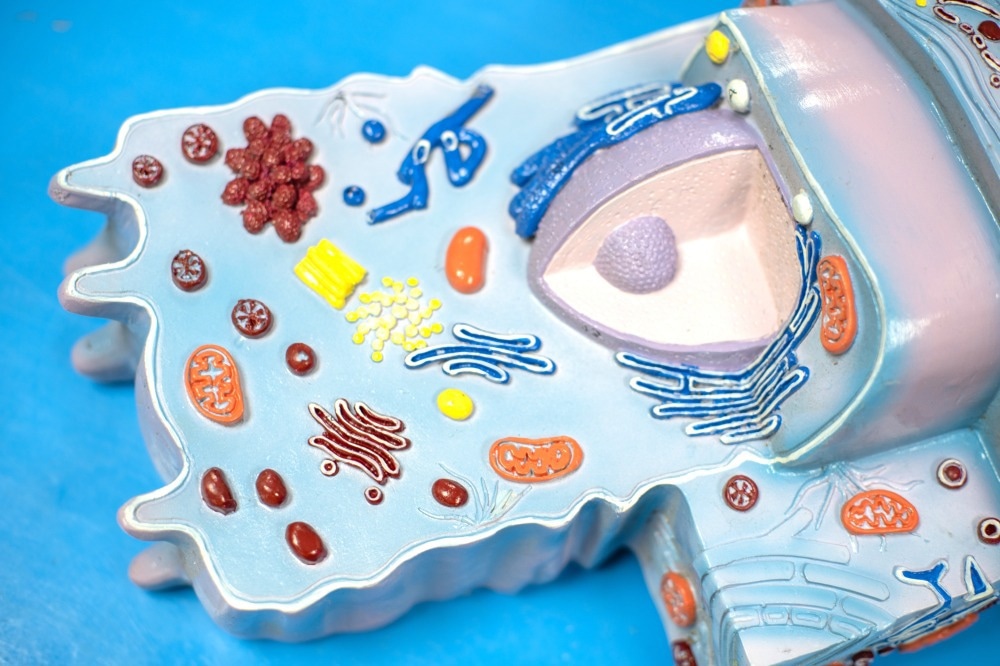Mitochondria are one of the more well-known organelles of the cell, as it is copiously branded as "The Powerhouse of the Cell". However, a little less known cellular organelle is also just as important – the peroxisome. First mentioned by Johannes Rhodin, a Swedish doctoral student, in 1954, it was not until the Belgian cytologist Christian de Duve identified the peroxisome as an organelle in 1967 - with that and his discovery of the lysosome, Duve shared the 1974 Nobel Prize in Physiology and Medicine.

Image Credit: Choksawatdikorn/Shutterstock.com
Being present in all eukaryotic organisms, from unicellular to multicellular and from plants to animals, the peroxisome comprises a single lipid bilayer, which is embedded with transporter proteins, as well as enzymes and a urate oxidase crystalline core, and it has been recognized as a major organelle responsible for many crucial metabolic processes. Interestingly, the peroxisome lacks DNA, in contrast with other cellular structures such as mitochondria, nucleus, and chloroplast - the chloroplast being strictly found in plant cells. All genetic codes required for peroxisome synthesis are consequently found in the nucleus.
Metabolic processes of the Peroxisome
The peroxisome is the site for several important metabolic processes. Such reactions include fatty acid metabolism, involving beta-oxidation and alpha-oxidation, which relates to very long chain fatty acids (VLCFA) and branch chain fatty acids (BCFA) metabolism, respectively. The entry of these fatty acids into the peroxisome is facilitated by the transporter proteins - known as peroxisomal ABC half-transporters due to the requirement of dimerization to be functional - found within the peroxisome's single lipid bilayer.
Upon entering the peroxisome, the VLCFA undergoes beta-oxidation, which ultimately produces Acetyl-CoA and Acyl CoA molecules, and as a side product, H2O2, whereby the BCFA is converted to VLCFA via alpha-oxidation. The acetyl-CoA produced as a result of beta-oxidation is important for the production of intermediates that would form cholesterol, which is vital for the synthesis of steroid hormone and bile acids, as well as being a structural component of the cell membrane. The acyl-CoA molecule, which is also produced as the result of the beta-oxidation, combines with dihydroxyacetone phosphate to form plasmalogen – a phospholipid that is important for myelin formation, whereby myelin creates a sheath, known as the myelin sheath, around the axons of nerve cells and enhances action potential propagation, therefore nerve cell communications.
Ethanol is also metabolized in the peroxisome, whereby the H2O2 side product from the beta-oxidation mentioned above is utilized to metabolize ethanol to acetaldehyde in the presence of the peroxisomal enzyme catalase, producing water and oxygen in the process. This is important not only for the detoxification process of ethanol as it also prevents the formation of destructive hydroxyl free radicals from hydrogen peroxide, whereby such free radicals are known to wreak havoc and destroy structural components of the cell.
It is also known for peroxisomes to have a role in the biosynthesis of bile acids, whereby the peroxisomal beta-oxidation is needed for the activation of bile acids, that is, converting C27-bile acid intermediates into mature C24-bile acids, with bile acids having the important role of lipid and glucose metabolism, absorption of dietary lipids and fat-soluble vitamins, as well as modulating the homeostasis of energy and temperature. Furthermore, newly synthesized bile acids are also conjugated within the peroxisome.
Diseases related to Peroxisome dysfunction
With the peroxisome having several functions, as described above, it is not surprising that there are multiple diseases related to malfunctioning the peroxisome, whereby no cures currently exist.
Zellweger syndrome
The biosynthesis and functioning of peroxisomes require proteins called peroxins. The genes that codes for peroxins are known as PEX genes, whereby there are 13 PEX genes and 37 known peroxin proteins. Zellweger syndrome, an autosomal recessive disorder, occurs when any of the PEX genes harbors defects, negatively affecting the formation and operations of the peroxisome. This results in cells of individuals with Zellweger syndrome having either a complete absence of functioning peroxisomes or a decreased number of functional ones or a combination of both – that is, some cells having no functioning peroxisomes and some with a low number of operating peroxisomes. And thus, the lack of functioning peroxisomes and/or reduced numbers of them results in H2O2 accumulation, lipid metabolism dysfunction - with the overabundance and accumulation of VLCFA and BCFA - as well as problems with the biosynthesis of cholesterol, bile acids, and plasmalogen.
Zellweger syndrome is also known as cerebrohepatorenal syndrome, which describes the tissues that are damaged due to the disease, that is, the nervous system (NS), liver, and kidneys - with damages to the NS causing hypertonia and seizures, liver damage leading to jaundice and kidney damage resulting in polycystic kidney disease.

Image Credit: luchschenF/Shutterstock.com
Refsum Disease
Refsum disease, also autosomal recessive, is brought about by the defects in genes that are required for alpha-oxidation, which thus consequentially induces the accumulation of BCFA in the NS, the skin, and the epiphyseal plates.
The consequence of such accumulation progresses to retinitis pigmentosa and neuropathy, in relation to the NS, as well as to ichthyosis and epiphyseal dysplasia, in association with the skin and epiphyseal plates, respectively.
Adrenoleukodystrophy
An X-linked recessive disorder, thus affecting disproportionately more males than females, adrenoleukodystrophy is the result of mutations in the ATP Binding Cassette Subfamily D Member 1 (APCD1) gene, the gene that encodes for the peroxisomal ABC half-transporter called ABCD1, hence affecting the transport of VLCFA and BCFA into the peroxisome. VLCFA and BCFA build-up observed in adrenoleukodystrophy occurs within the NS, resulting in dementia and adrenal insufficiency.
Conclusion
It is evident that the peroxisome has many vital metabolic roles and functions, and as such, may deserve to be known as "The Metabolic Factory of the Cell," similar to that of the title bestowed upon the mitochondrion. Doing so may bring much-needed attention and further research in creating therapeutic paths to tackle the myriad of incurable diseases that arise due to peroxisomal dysfunction.
Read Next: Enhancing the Function of Mitochondria Using Deep Red Light
Sources:
- Rhodin J. Correlation of ultrastructural organization and function in normal and experimentally changed proximal convoluted tubule cells of the mouse kidney. Doctoral Thesis., Karolinska Institutet, Stockholm, Aktiebolaget Godvil. 1954;1.
- de Duve C. The peroxisome: a new cytoplasmic organelle. Proc R Soc Lond B Biol Sci. 1969;173(1030):71-83.
- Joshi S, Subramani S. Peroxisomes. Encyclopedia of Biological Chemistry. 2013;:425-430.
- Blobel G. Christian de Duve (1917–2013). Nature. 2013;498(7454):300-300.
- Tawbeh A, Gondcaille C, Trompier D, Savary S. Peroxisomal ABC Transporters: An Update. International Journal of Molecular Sciences. 2021;22(11):6093.
- Handler J, Thurman R. Rates of H2O2 generation from peroxisomal β-oxidation are sufficient to account for fatty acid-stimulated ethanol metabolism in perfused rat liver. Alcohol. 1987;4(2):131-134.
- Ferdinandusse S, Houten S. Peroxisomes and bile acid biosynthesis. Biochimica et Biophysica Acta (BBA) - Molecular Cell Research. 2006;1763(12):1427-1440.
- Keitel V, Kubitz R, Häussinger D. Endocrine and paracrine role of bile acids. World Journal of Gastroenterology. 2008;14(37):5620.
- Jansen R, Santana-Molina C, van den Noort M, Devos D, van der Klei I. Comparative Genomics of Peroxisome Biogenesis Proteins: Making Sense of the PEX Proteins. Frontiers in Cell and Developmental Biology. 2021;9.
- Zellweger Syndrome | National Institute of Neurological Disorders and Stroke [Internet]. Ninds.nih.gov. 2022 [cited 10 October 2022]. Available from: https://www.ninds.nih.gov/health-information/disorders/zellweger-syndrome
- Charles K, Shackelford J, Faust P, Fliesler S, Stangl H, Kovacs W. Functional Peroxisomes Are Essential for Efficient Cholesterol Sensing and Synthesis. Frontiers in Cell and Developmental Biology. 2020;8.
- Refsum Disease | National Institute of Neurological Disorders and Stroke [Internet]. Ninds.nih.gov. 2022 [cited 10 October 2022]. Available from: https://www.ninds.nih.gov/health-information/disorders/refsum-disease
- Wall W, Worthington B. Skeletal changes in Refsum's disease. Clinical Radiology. 1979;30(6):657-659.
- Kemp S, Pujol A, Waterham H, van Geel B, Boehm C, Raymond G et al. ABCD1 mutations and the X-linked adrenoleukodystrophy mutation database: Role in diagnosis and clinical correlations. Human Mutation. 2001;18(6):499-515.
- Tamagaki C, Murata A, Ohara T, Sakata T, Takase K, Okugawa G et al. Adrenoleukodystrophy initially presenting with symptoms of dementia. Psychogeriatrics. 2007;7(4):163-165.
- Adrenoleukodystrophy | National Institute of Neurological Disorders and Stroke [Internet]. Ninds.nih.gov. 2022 [cited 10 October 2022]. Available from: https://www.ninds.nih.gov/health-information/disorders/adrenoleukodystrophy.
Further Reading
Last Updated: Jan 20, 2023